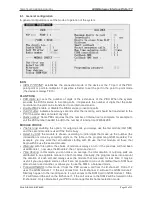
TEMA TELECOMUNICAZIONI SRL
GSM Gateway Interface DIAL-112
MAS-DIAL112-REV06EN
Page 10 of 35
6. INSTALLATION AND DIAGNOSTICS
DIAL-112 has two GSM modules that require 2 SIM cards from the telephone operators to work.
The procedure for registering the SIM card on the wireless network when the device is turned on is
automatic and identical to that of a normal GSM telephone.
6.1.
Installation of the DIAL-112 unit
In addition to resting on table, a desktop or shelf, the DIAL-112 unit can be wall-mounted, using the
appropriate slots located on its rear panel.
To do that proceed as follows:
•
Attach the DIAL-112 to the wall, with the antennas connectors facing upwards.
•
Manually screw the antennas connectors (do not use a wrench).
•
Connect the ISDN cable from the “TE-Pbx” port to the ISDN port of your PBX (or to a self-
powered ISDN phone).
•
For each GSM module, insert the SIM card.
To insert the SIM card into DIAL-112, use a small screwdriver or pen point to press the
centre of the yellow button on the front slot with the SIM holder. Remove the holder and
insert the SIM with the gold contacts facing upwards. Note that there is only one correct
way to place the SIM in the holder. Now, carefully align the holder in the slot and insert it
until it stops in its operating position.
Note
To avoid damaging DIAL-112 or the SIM card, make sure the unit is disconnected from its
power supply before inserting or removing the SIM card.
Important tips for proper operation
We recommend disabling the PIN code request, voice mail, all call diversions (such as
when busy, absent or not available) and call notifications on the SIM card before inserting
the SIM in the DIAL-112, using a normal GSM device with keypad.
•
Connect the power supply cord.
6.2. Connection modes
ISDN is a digital system in which communications between various devices must be synchronized
with a common clock. Some PBX (including Alcatel, Ericsson, Philips, Selta, Siemens) can not
tolerate a lack of synchronization between different TE ports.
If you use a PBX with these characteristics is necessary to connect an output of NT at "Sync-NT"
input of DIAL-112 in order to keep the DIAL-112 clock synchronized with other present devices on
NT ports. To connect, use a cable with only 2 connection wires inside (only the RX to the device).
In the diagrams on the following pages are presented several solutions for connecting where are
highlighted the connections and the possible source of signal synchronization.
For the sole purpose of synchronization, DIAL-112 must be connected to a normal NT port, in
order to receive the same clock that the NT port sends to the PBX and on which the PBX
synchronizes (showed in the images with a dotted line).

























